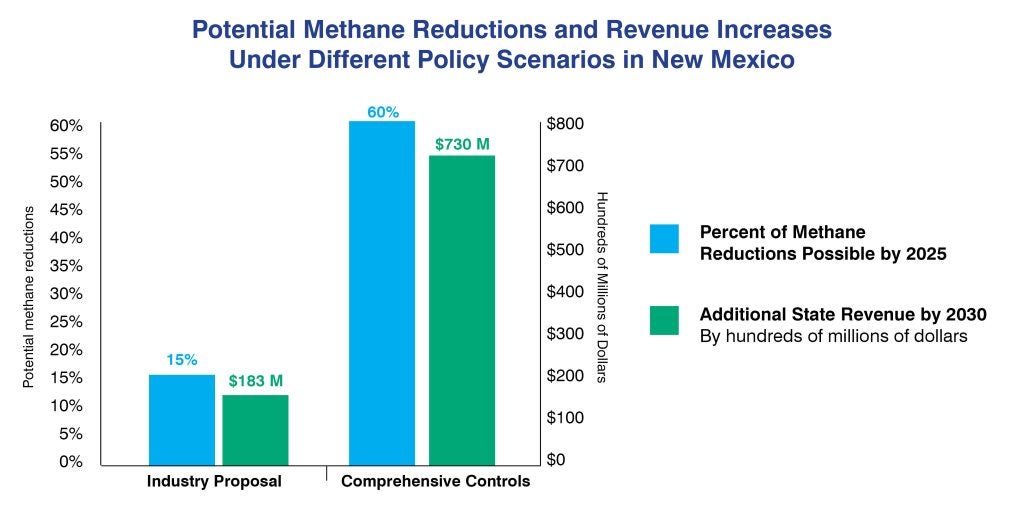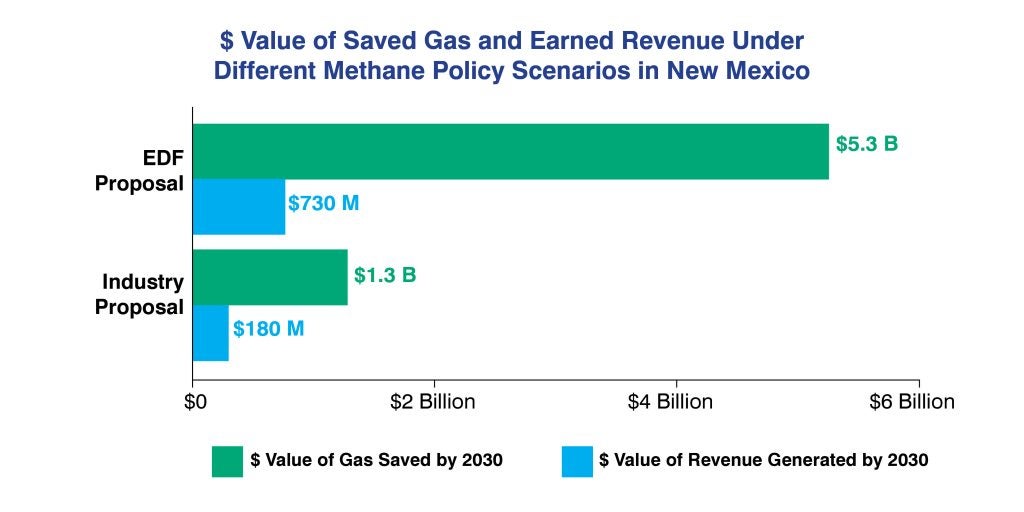By Jon Goldstein and Hillary Hull
A new EDF analysis reveals that, over the next five years, New Mexico policymakers have the opportunity to eliminate up to 60% of methane emissions stemming from the oil and gas industry by implementing a suite of nationally leading controls.
Methane is a potent climate pollutant and the main ingredient in natural gas. Methane that escapes from oil and gas facilities is damaging to the climate and the state’s economy.
Our analysis finds that by implementing leading practices for methane capture, New Mexico can make a serious dent in its headline-making pollution problem, save more than $5 billion worth of natural gas and add more than $730 million to the state budget over the next decade. These measures will protect children’s health and improve education funding for the next generation of New Mexicans.
Diving deep with data
Earlier this year, we drew on the latest methane research and the first publically available direct methane measurements from the Permian Basin, and found that New Mexico oil and gas operators emit about one million metric tons of methane a year, five times more than previously understood.
New analysis shows golden opportunity for New Mexico to dramatically reduce oil and gas methane pollution Share on XFor the next phase of the New Mexico analysis released today, we assessed the impact two different pollution control scenarios would have on methane volumes over the next decade.¹
- In one scenario, we used the policy recommendations of the New Mexico Oil and Gas Association.
- In the other, we used EDF’s policy recommendations, which are based on successful practices currently in use in other oil- and gas-producing regions.
Our modeling tool allows users to explore the difference between alternate management strategies. As a whole, we conclude that the framework presented by the state’s oil and gas industry only has the capacity to reduce 15% of methane emissions compared to the 60% reduction possible in the next five years if the state enacts nationally leading controls, such as quarterly leak inspections at all wells and associated equipment and replaces pneumatic pumps and controllers with “low” or “no-bleed” technologies. These requirements have all been implemented by leading oil and gas regulators and found unequivocally to be cost effective at driving significant reductions in methane pollution and waste from the oil and gas industry.
These results again underline the inadequacy of NMOGA’s proposal that, if adopted, would constitute the weakest methane regulations in the U.S.
Who wins and who loses under weak methane standards
Because capturing methane can generate revenue for the state, we also looked at the economic impacts of the different policy scenarios. Under the most comprehensive scenario, we found that by 2030 New Mexico could earn over $730 million in additional revenue to go toward critical state needs like education funding. Under the industry’s proposed model New Mexico would see significantly smaller returns, about $180 million — or about one-quarter of the savings under more robust standards.
We also looked at potential risks and benefits to the vulnerable communities living near the oil and gas fields. The pollution that leaks from oil and gas equipment contains harmful pollutants that can exacerbate asthma and cause cancer. Populations living close to these oil and gas facilities, particularly young children and the elderly, are at much greater risk for these health impacts. For example, there are nearly 9,000 children under the age of five living in San Juan County (home to New Mexico’s infamous methane hot spot) and over 78% of these young kids live within one mile of an active oil or gas well. In Southeastern New Mexico the numbers are equally striking: 80% of young children in Eddy County and 68% in Lea County also live within one mile of a well. Environmental policies that help reduce 60% of industry’s pollution, as opposed to just 15%, would therefore make a big difference to these families.
Learn about pollution impacts in your county here.
Deploying methane standards where they’re needed most
The good news is that earlier this year, Gov. Michelle Lujan Grisham directed her administration to work collaboratively with stakeholders across the state to develop nationally leading rules to fix the state’s methane problem. Community meetings kick off early next week in Farmington, Albuquerque and Carlsbad to hear input as the state develops these rules.
It’s clear we have the data and tools we need to reduce methane pollution and protect New Mexico’s most vulnerable communities. There’s a clear path forward on sensible methane policy that delivers significant reductions in harmful pollution and increases in state revenue, it’s up to the state, the oil and gas companies and all of us impacted by oil and gas pollution to take it.
¹Future methane emissions levels based on projections from Rystad Energy, a leading industry analytics firm











